| Article ID | Journal | Published Year | Pages | File Type |
|---|---|---|---|---|
| 3367671 | Journal of Autoimmunity | 2016 | 8 Pages |
•The presence of giant cells, laminar necrosis and calcifications at TAB correlates with ischemic manifestations of GCA.•The severity of mural inflammation at TAB correlates with cranial manifestations and halo sign at temporal artery CDS.•Fibrinoid necrosis is not a feature of GCA.•These findings may have clinical and prognostic significance and thus implications for patients’ management.
ObjectiveTo correlate histopathological features of positive temporal artery biopsy (TAB) and clinical manifestations of the disease in a large single-center population-based cohort of patients with biopsy-proven giant cell arteritis (GCA).MethodsA pathologist with expertise in vasculitis and blinded to clinical data and final diagnosis reviewed all TABs performed for suspected GCA at our hospital between January 1986 and December 2013. Histopathologic features evaluated were: the severity of inflammation and intimal hyperplasia, both graded on a semiquantitative scale (mild = 1, moderate = 2, severe = 3), the presence of intraluminal acute thrombosis, calcifications, giant cells, fibrinoid necrosis and laminar necrosis.Results274 patients had a final diagnosis of biopsy-proven GCA and were included in the study. Cranial ischemic events (CIEs) were observed in 161 (58.8%), visual manifestations in 79 (28.8%) and permanent (partial or complete) visual loss in 51 (18.6%) patients. Predictors for the development of CIEs were older age (OR = 1.057, 95% CI 1.019–1.097, p = 0.003), lower ESR values (OR = 0.990, 95% CI 0.981–0.999, p = 0.026) as well as the presence of giant cells (OR = 1.848, 95% CI 1.045–3.269, p = 0.035) and laminar necrosis at TAB (OR = 2.334, 95% CI 1.187–4.587, p = 0.014). Predictors for the development of permanent visual loss were lower CRP values (OR = 0.906, 95% CI 0.827–0.992, p = 0.033) and the presence of calcifications at TAB (OR = 3.672, 95% CI 1.479–9.121, p = 0.005). Fibrinoid necrosis was not observed in any of the TABs evaluated.ConclusionPathological features of TAB may predict some manifestations of GCA. These findings may have implications for patients' management.
